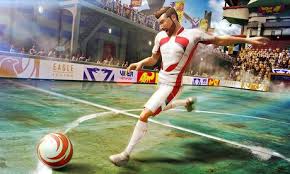Aperture Desk Job
LQ: 8.8
Recommended Age: 8+
Skills Used: Focus, Working Memory, Reading

Kinect Sports Rivals is the latest entry in the popular fitness game series, which uses the Xbox One’s Kinect camera sensor to detect players movements — allowing them to control the game with their body movements. The compilation contains seven sports in all, including bowling, jet ski racing, rock climbing, soccer, target shooting, and tennis. Players compete against each other side by side or choose to tackle a single-player campaign. The game is rated E10+ by the ESRB, but due to its ease of use and lack of inappropriate content, we recommend Kinect Sports Rivals to kids as young as 8.
Adapting and adjusting to changing conditions and expectations.
 The numerous sports and activities offered by the game have players performing a wide variety of movements and actions, and each requires unique controls and strategy. Steering during jet ski races, lining up shots in bowling, timing kicks in soccer or swings in tennis and shooting with precision during target practice. Within each activity there are changes in pace, with different movements required and obstacles to maneuver around, helping kids learn to adapt to new situations and discover various ways to tackle a problem.
The numerous sports and activities offered by the game have players performing a wide variety of movements and actions, and each requires unique controls and strategy. Steering during jet ski races, lining up shots in bowling, timing kicks in soccer or swings in tennis and shooting with precision during target practice. Within each activity there are changes in pace, with different movements required and obstacles to maneuver around, helping kids learn to adapt to new situations and discover various ways to tackle a problem.
Getting started and then maintaining attention and effort to tasks.
 In order to learn how to control the game using the Kinect, players will need to pay close attention to the tutorial and follow along with the directions given to them by the game's "Coach." Across all sports, players will learn specific gestures and body movements that allow them to control the game, which take a level of concentration and timing to perform correctly.
In order to learn how to control the game using the Kinect, players will need to pay close attention to the tutorial and follow along with the directions given to them by the game's "Coach." Across all sports, players will learn specific gestures and body movements that allow them to control the game, which take a level of concentration and timing to perform correctly.
Physical exercise that involves complex body movement and keen coordination also has benefits for improving the focus thinking skill. Research shows that vigorous physical activity can also help boost attention and concentration for up to 4 hours after exercise.
Managing feelings, actions and behaviors.
Honing one’s skills in the various game modes included with Kinect Sports Rivals takes time. In order to develop the movement and coordination needed to play, players need to remain calm and motivated, taking time to learn the basics. To be successful in Kinect Sports Rivals, players will have to exert careful control over their movements. The speed, form, and direction of a gesture all contribute to the end result. Being able to replicate movements at the right time takes practice and refined motor skills. Emotional self-regulation is required, as well, particularly if a player is struggling. They need to keep cool and not get flustered or too frustrated, as doing so will only make it harder to keep up with the game and also make it unpleasant for other players involved.
Use this PlayTogether guide to learn how you can help your child turn Kinect Sports Season Two: Tennis play time into a positive learning and relationship-building experience. To learn more about why playing games with your children is so important, check out our Science of Play page!
Take a minute to talk with your child about how the Flexibility, Focus, and Self-Control thinking skills work, and why they are important for success in school and at home.
 Kinect Sports Rivals has single- and multiplayer game modes, but the best way to play with your child is to play competitively. Because Kinect Sports Rivals lets players enjoy the action simultaneously, both players can work together to meet the gameplay goals listed below.
Kinect Sports Rivals has single- and multiplayer game modes, but the best way to play with your child is to play competitively. Because Kinect Sports Rivals lets players enjoy the action simultaneously, both players can work together to meet the gameplay goals listed below.
Gameplay Goals:
After you have completed the gameplay goals above, take a minute to pause the game and talk with your child about how the game is exercising your Self-Control, Focus and Flexibility skills.
Our Make it Work activities are designed to transform your child’s gameplay into real-world improvements in thinking and academic skills. If you’re just getting started with LearningWorks For Kids, we suggest you try them all to find which are the best for you and your child.
Read over our Flexibility, Focus, and Self-Control pages, and then take some time to introduce these thinking skills to your child.
Explain That:
Play games that change tempo. One example of this is the game of Hide and Seek where the players each get alternating chances to run around and be quietly still. Games such as this, that involve taking turns and shifting the order of turns can help to build flexibility skills. These suggestions are particularly useful for children who have difficulty with transitions or who tend to have problems regulating their behavior.
 Use competition to sustain focus. For instance, challenge your child to a race. Tell her to see whether she can fully complete a portion of her homework before you finish putting away the groceries after shopping. If your child has a competitive nature, encourage her to come up with strategies for competing against herself or others. Engage siblings, friends or other caregivers in these friendly contests.
Use competition to sustain focus. For instance, challenge your child to a race. Tell her to see whether she can fully complete a portion of her homework before you finish putting away the groceries after shopping. If your child has a competitive nature, encourage her to come up with strategies for competing against herself or others. Engage siblings, friends or other caregivers in these friendly contests.
 Delay impulsive behaviors. You can provide some easily learned strategies that will train your child to practice self-restraint. Help your child to identify situations that require self-control and encourage him to think of actions that will make it easier to remember and practice. The following are some ideas for practicing response inhibition with your child:
Delay impulsive behaviors. You can provide some easily learned strategies that will train your child to practice self-restraint. Help your child to identify situations that require self-control and encourage him to think of actions that will make it easier to remember and practice. The following are some ideas for practicing response inhibition with your child:
 Active games can have numerous benefits for children with ADHD. Firstly, physical exercise that involves complex body movement and keen coordination. The motion-based gameplay found in Kinect Sports Rivals requires a fair amount of physcality, along with good concentration and focus. Players will likely not do too well at first, requiring them to practice and exert a level of commitment in order to become good at the game.
Active games can have numerous benefits for children with ADHD. Firstly, physical exercise that involves complex body movement and keen coordination. The motion-based gameplay found in Kinect Sports Rivals requires a fair amount of physcality, along with good concentration and focus. Players will likely not do too well at first, requiring them to practice and exert a level of commitment in order to become good at the game.
Additionally, research shows that vigorous physical activity can help boost attention for up to 4 hours after exercise. Basically, exercise boosts the production of brain fuel, which sticks around for a while even after the exercise is done. This makes exercise and active games a smart playtime activity for children, especially before tackling attention-demanding tasks, such as homework or studying.
All membership plans come with full access to our entire suite of tools learning guides, and resources. Here are a few of the ones we think you’ll like the most: